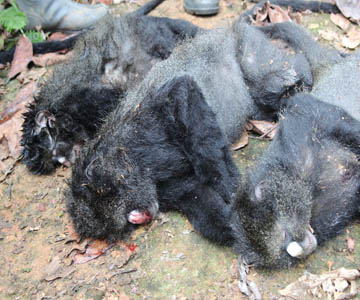Here in the United States, we have laws that control the preparation, consumption, and trade of meat, ensuring that animals are treated appropriately, kept healthy, and sold legally. This is not the case in some countries in Africa and other parts of the world. Many of Africa’s rare and globally-important wildlife species are endangered with extinction. Although habitat loss is a major cause of wildlife decline, the most immediate threat to the future of wildlife in Africa and around the world is the illegal trade and consumption of "bushmeat."

Credit: Richard Ruggiero
In Africa, forests and savannas are commonly referred to as “bush”, hence the name bushmeat. Many rural communities depend on hunting wildlife for subsistence, and their ability to sustainably harvest wildlife is an essential part of their lives and well-being. In this discussion, the ‘bushmeat trade’ refers to the illegal and unsustainable over-hunting of wildlife for meat and income. Some animals affected by this illegal activity include gorillas, chimpanzees and other primates, elephants, antelopes, crocodiles, fruit bats, porcupines and other rodents, and several species of pangolin. These animals may be killed with wire snares, firearms, poisoning, and sometimes using hunting dogs.
The growing problem posed by illegal, unsustainable hunting for bushmeat is exacerbated by the construction of new roads to facilitate logging and mining operations, allowing poachers easy access to remote forests. In villages or logging camps where meat from domesticated animals is scarce and expensive, wild animals are hunted as a cheap and locally available source of protein. In many African cities, eating bushmeat has become a status symbol for the wealthy and the demand for wild meat has steadily increased. Although the practice earns hunters and traders quick cash in the short-term, it is ultimately unsustainable, and denies opportunities for the wider community and future generations to benefit from wildlife.
Although a growing problem in East and Southern Africa, Central and West Africa have experienced the worst of this crisis. With approximately one million metric tons of bushmeat consumed each year in Central Africa, unsustainable bushmeat hunting is considered the single greatest threat to wildlife. The illegal bushmeat trade has led to what is commonly referred to as the "Empty Forest Syndrome," a condition where forests remain structurally intact but are largely devoid of wildlife. The loss of wildlife biodiversity also disrupts natural ecological processes such as pollination and seed dispersion, leading to the further degradation of the overall ecosystem.
Although the bushmeat trade is of great concern in Africa, there are similar situations in other areas of the world. In Asia, pangolins, an endangered scaly-skinned mammal, are highly sought after for meat. Most wildlife trade in Asia is with live animals, unlike Africa where they have been killed already. In Latin America, where the USFWS also has programs in place to combat bushmeat trade, between five to eight million people rely on bushmeat as a primary source of protein in their diets.
On an annual basis, thousands of pounds of primate parts, antelope, and other bushmeat are smuggled into the United States and Europe every year for cultural events. This practice is cause for concern as it may introduce new emerging infectious diseases. Ebola Hemorrhagic Virus, among others communicable diseases, may be transmitted to humans through the hunting of and consumption of gorillas. The enhanced risk of disease transmission due to the illegal international bushmeat trade is not well understood, but it poses an enormous potential danger to people and wildlife around the world.
Despite the challenge that the illegal, commercial bushmeat trade poses, there are methods and means to address it. Through the Great Ape Conservation Fund, grants are being provided to partners in West and Central Africa to address the hunting of gorillas, chimpanzees, and bonobos for bushmeat. The USFWS has supported the development of unique law enforcement partnerships between wildlife authorities and civil society groups in four Central African countries to investigate and prosecute wildlife crimes, conduct public outreach campaigns, reduce corruption and curtail the illegal wildlife and bushmeat trade. The Fund also supports education, community management schemes, and improved protected area management to reduce the bushmeat trade.
The Bushmeat-free Eastern Africa Network (BEAN) is a network of regional conservationists and other stakeholders dedicated to stopping the illegal bushmeat trade. It emerged from the USFWS MENTOR Fellowship Program in 2008 and 2009 sponsored by the Wildlife Without Borders-Africa program. The network conducts education campaigns, works to strengthen law enforcement efforts and promotes alternatives to bushmeat. The USFWS supports many efforts by partners to address the illegal bushmeat trade.

